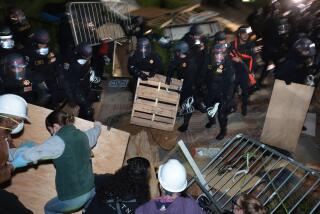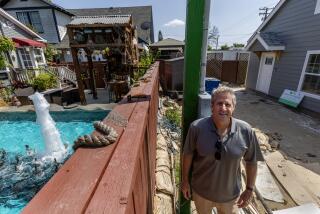A Mikvah Revival Is Building in O.C. : Judaism: With four ritual baths now planned, purification ceremony will no longer require travel.
At a Jewish ritual bath in Long Beach, Michele Boldt of Irvine took off her clothes and removed her nail polish, jewelry and makeup. She walked down the seven pale steps and immersed herself--not only in the warm waters of the mikvah, but in centuries of Jewish tradition and her connection to God.
Boldt, an Orthodox Jew, has spent years schlepping to Los Angeles County for her monthly ritual bath. But with construction of four mikvahs planned in Orange County, the 27-year-old mother of two knows she won’t long be driving so far for her monthly immersion.
Three local synagogues are planning to break ground on mikvahs this year: Temple Bat Yahm, a Reform congregation in Newport Beach; the Orthodox Beth Jacob Congregation in Irvine and the Hasidic Orthodox Chabad of Laguna. A fourth, Hasidic synagogue, the North County Chabad Center/Congregation Beth Meir HaCohen of Yorba Linda, also has plans for a mikvah.
Mikvahs are used by all branches of Judaism, most commonly for purification before a marriage and for converts to the faith.
Jews have also been known to use the baths as a point of renewal after experiencing divorce or physical abuse. Increased demand for mikvahs reflects a broader yearning for tradition seen in many Jewish congregations, say rabbis.
“As more Jews learn about their traditions, there’s a greater sense of loyalty to their ideals,” said Rabbi David Eliezrie of North County Chabad.
Starting Friday, many Orthodox Jews will seek the purification offered by the mikvah during the High Holy Days, which begin with Rosh Hashana, the Jewish new year, and end with Yom Kippur, the Day of Atonement. This is the time of year when men, bound by different rules than women, are most likely to use mikvahs as a way of washing away the sins of the last year.
Among mikvahs frequented by Orange County Jews is one at the University of Judaism in Los Angeles. Thousands of people have immersed themselves in the warm water of the center’s small ritual bath since it was built 16 years ago.
The mikvah, set in a small white-tiled room off a courtyard on the ground floor, looks much like a square Jacuzzi, about 5 feet on each side. Users enter the blue-tiled bath one at a time, recite Hebrew blessings and immerse themselves three times in a ritual that is over in minutes. Each is alone in the room but for a witness who sits in a chair nearby and, occasionally, a rabbi who recites prayers from behind a curtain.
In an adjacent room women shower before the immersion. Bottles of polish remover and lotions and shampoos line the shelves, which are also stacked with clean white towels. It’s important to wash and remove makeup before entering a mikvah so that nothing gets between a person and the water, rabbis say.
Lillian Zelcer, who has long served as escort and mother hen to people who are vulnerable and naked at the mikvah, has seen a surge in the numbers of people booking appointments for the ritual dunking--a ceremony that costs $25 to $150.
“For women, this is a very special place,” she said. “It gives you a sense of healing and hope for the future.”
*
Though it may look like a simple bath, a mikvah must be built and operated according to strict rules. Among them is the requirement that its waters be natural--rainwater, spring water or ocean water, for example. In lieu of a mikvah, many West Coast Jews use the Pacific itself.
In addition, the waters may not touch metal and must not be transported from their source. This means many mikvahs must be equipped with a holding tank to catch rainwater, which is then funneled to the bath in clay pipes.
Where natural water is not abundant, some synagogues must resort to a technicality to meet the requirements: They freeze natural water at its source and move it as ice. The ice is then thawed at the mikvah in clay containers.
The ritual bath is perhaps most important for Orthodox women, who are expected to go to a mikvah monthly. The purification ceremony follows menstruation and at least 12 days of abstinence from sex each month.
Rabbi Joel Landau of Beth Jacob said the monthly ritual should be seen as a woman’s acknowledgment that she had not conceived a child that month. “She had the potential to nurture a human being inside of her, and that potential was lost.”
But the practice fell into disfavor in recent decades among many American women, who saw it as demeaning, said Rabbi Laura Geller, a Reform rabbi at Temple Emmanuel in Beverly Hills and founder of the Jewish Feminist Center in Los Angeles.
“Mikvah was used over the years for family purity, which is something that many modern women have rejected,” she said. “As women rejected it, they lost connection with the mikvah as a source of healing.”
Family purity refers to a set of laws regarding sexual behavior within marriage, some of which carry the implication that women are impure while menstruating.
In recent years, however, many women--including those of the more liberal Reform branch of Judaism--have come to see the mikvah as a source of healing, even if they remain uncomfortable with a monthly purification, she said.
“Now, as feminism has enabled us to reclaim our traditions and use them in different ways, you find many people using mikvah not for family purity but for healing and transformative ceremonies.”
Indeed, it’s outside the Orthodox community where mikvahs are seeing their greatest resurgence and rediscovery, said Rabbi Alice Dubinsky, acting director of the Union of American Hebrew Congregations in Los Angeles.
“There is absolutely a mikvah revival,” she said.
*
The new popularity of mikvahs is part of a larger trend, rabbis say, toward revival of tradition across all branches of the Jewish faith in America.
For example, the governing body of Reform Judaism recently endorsed a return to traditional practices such as wearing yarmulkes, keeping kosher and praying in Hebrew--customs that had fallen out of common use among the largest and most secularized branch of Judaism.
The growth in Jewish observance in part comes as a reaction to assimilation and intermarriage as well as intensive efforts at religious education, said Eliezrie of North County Chabad. Jews who want to maintain their faith are motivated to renew their attachment to rituals that separate them from Christians, he said.
Indeed, congregants have been clamoring for a mikvah in Orange County, rabbis said.
“This is not a money-maker, but a service we want to offer our congregation and anyone else in the community,” said Rabbi Mark Miller of Temple Bat Yahm. “We are harking back to our spiritual roots.”
(BEGIN TEXT OF INFOBOX / INFOGRAPHIC)
Water Ritual
The mikveh is a ritual bath used by Jews for spiritual purification and renewal. Modern mikvehs resemble tiny swimming pools, but are constructed and used according to ancient Jewish teachings and traditions.
The Mikveh
The Pools
* Often built as two adjoining pools. One contains water from a natural source. The other is filled with heated, chlorinated water and is where the actual immersion takes place. Waters from the two pools touch through a hole bored in the wall between them.
* Must be built into the ground or as an integral part of the building. No portable or above-ground construction.
The Water
* Collection pool must contain 40 se’ahs (approximately 191 gallons) of water from a natural source such as rain, a spring, river or ocean. It cannot have touched metal or be transported in liquid form from its source. Many utilize rainwater from a rooftop collection system or water that has been frozen at its source and melted into the pool.
The Ritual
* Participant showers in an adjoining preparation area. All clothing, makeup, nail polish, hair spray, contact lenses and jewelry must be removed.
* Participant steps into pool and immerses entire body at once, with legs, arms, fingers and toes spread so water can touch every surface of the body. He or she then surfaces to recite a prayer of purification before immersing two more times. An attendant is present to assure safety and correct performance of the ritual.
When Is a Mikveh Used?
* A bride and groom separately before their wedding
* Before major Jewish holidays
* As the final step of converting to Judaism
* By married women after their monthly menstrual cycle
Graphics reporting by JANICE JONES DODDS / Los Angeles Times
Source: “Total Immersion” by Rivkah Slonim; Jason Aronson, Inc., 1996; Beth Jacob Congregation, Temple Bat Yahm
More to Read
Start your day right
Sign up for Essential California for news, features and recommendations from the L.A. Times and beyond in your inbox six days a week.
You may occasionally receive promotional content from the Los Angeles Times.






